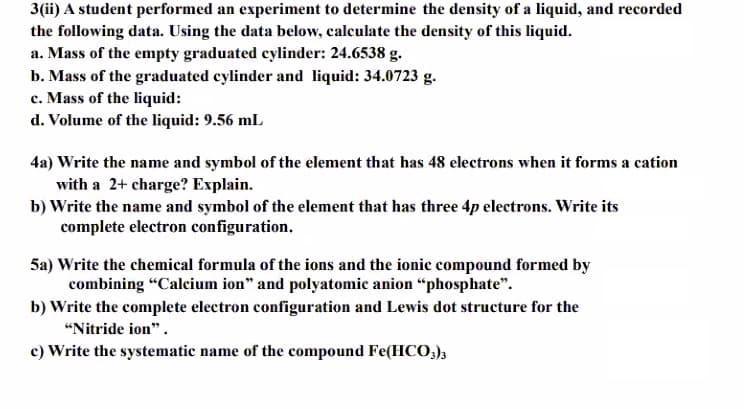3(ii) A student performed an experiment to determine the density of a liquid, and recorded the following data. Using the data below, calculate the density of this liquid. a. Mass of the empty graduated cylinder: 24.6538 g. b. Mass of the graduated cylinder and liquid: 34.0723 g. c. Mass of the liquid: d. Volume of the liquid: 9.56 mlL
3(ii) A student performed an experiment to determine the density of a liquid, and recorded the following data. Using the data below, calculate the density of this liquid. a. Mass of the empty graduated cylinder: 24.6538 g. b. Mass of the graduated cylinder and liquid: 34.0723 g. c. Mass of the liquid: d. Volume of the liquid: 9.56 mlL
Chemical Principles in the Laboratory
11th Edition
ISBN:9781305264434
Author:Emil Slowinski, Wayne C. Wolsey, Robert Rossi
Publisher:Emil Slowinski, Wayne C. Wolsey, Robert Rossi
Chapter1: The Densities Of Liquids And Solids
Section: Chapter Questions
Problem 2ASA: Finding the density of an unknown liquid. Having obtained the volume of the flask, the student...
Related questions
Question

Transcribed Image Text:3(ii) A student performed an experiment to determine the density of a liquid, and recorded
the following data. Using the data below, calculate the density of this liquid.
a. Mass of the empty graduated cylinder: 24.6538 g.
b. Mass of the graduated cylinder and liquid: 34.0723 g.
c. Mass of the liquid:
d. Volume of the liquid: 9.56 mL
4a) Write the name and symbol of the element that has 48 electrons when it forms a cation
with a 2+ charge? Explain.
b) Write the name and symbol of the element that has three 4p electrons. Write its
complete electron configuration.
5a) Write the chemical formula of the ions and the ionic compound formed by
combining "Calcium ion" and polyatomic anion “phosphate".
b) Write the complete electron configuration and Lewis dot structure for the
“Nitride ion".
c) Write the systematic name of the compound Fe(HCO,)3
Expert Solution
This question has been solved!
Explore an expertly crafted, step-by-step solution for a thorough understanding of key concepts.
This is a popular solution!
Trending now
This is a popular solution!
Step by step
Solved in 2 steps with 1 images

Knowledge Booster
Learn more about
Need a deep-dive on the concept behind this application? Look no further. Learn more about this topic, chemistry and related others by exploring similar questions and additional content below.Recommended textbooks for you

Chemical Principles in the Laboratory
Chemistry
ISBN:
9781305264434
Author:
Emil Slowinski, Wayne C. Wolsey, Robert Rossi
Publisher:
Brooks Cole

Chemistry
Chemistry
ISBN:
9781305957404
Author:
Steven S. Zumdahl, Susan A. Zumdahl, Donald J. DeCoste
Publisher:
Cengage Learning

World of Chemistry, 3rd edition
Chemistry
ISBN:
9781133109655
Author:
Steven S. Zumdahl, Susan L. Zumdahl, Donald J. DeCoste
Publisher:
Brooks / Cole / Cengage Learning

Chemical Principles in the Laboratory
Chemistry
ISBN:
9781305264434
Author:
Emil Slowinski, Wayne C. Wolsey, Robert Rossi
Publisher:
Brooks Cole

Chemistry
Chemistry
ISBN:
9781305957404
Author:
Steven S. Zumdahl, Susan A. Zumdahl, Donald J. DeCoste
Publisher:
Cengage Learning

World of Chemistry, 3rd edition
Chemistry
ISBN:
9781133109655
Author:
Steven S. Zumdahl, Susan L. Zumdahl, Donald J. DeCoste
Publisher:
Brooks / Cole / Cengage Learning


Introductory Chemistry: A Foundation
Chemistry
ISBN:
9781337399425
Author:
Steven S. Zumdahl, Donald J. DeCoste
Publisher:
Cengage Learning

Chemistry by OpenStax (2015-05-04)
Chemistry
ISBN:
9781938168390
Author:
Klaus Theopold, Richard H Langley, Paul Flowers, William R. Robinson, Mark Blaser
Publisher:
OpenStax